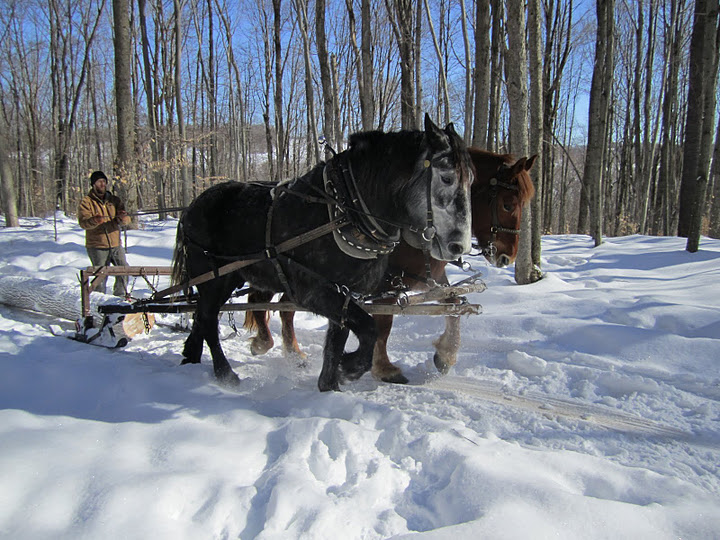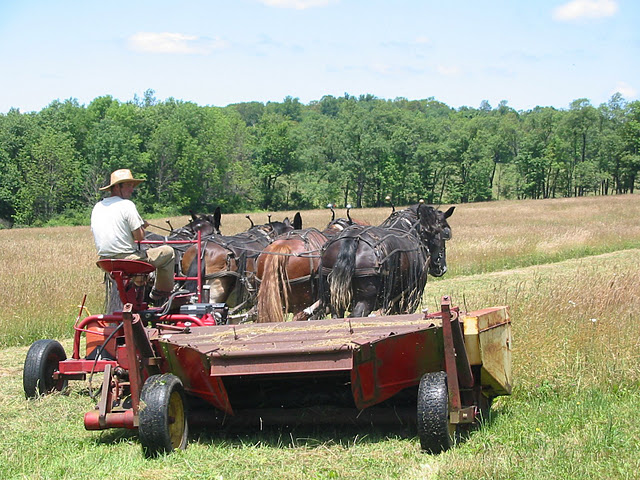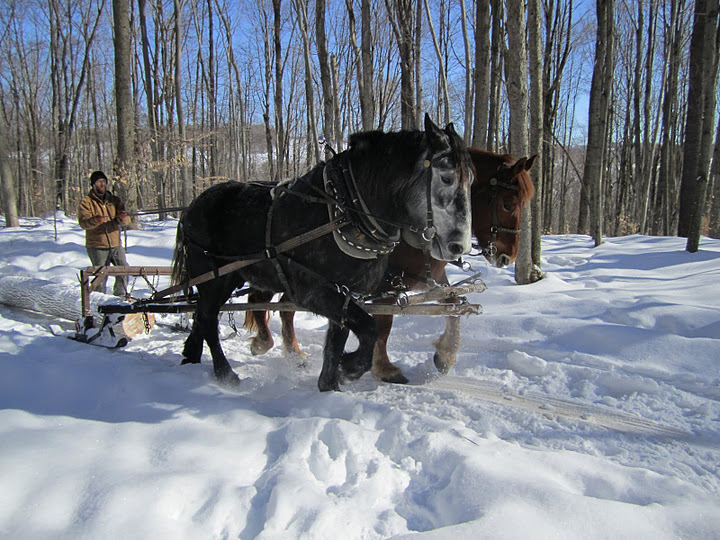 Photo: Donn HewesAsk any 5-year-old: Few tools symbolize the farm like a trundling tractor. In fact, you’d have to reach further back in time to find an equally enduring symbol: the horse. And while there’s little doubt that tractors have revolutionized farm labor and made farms much more efficient than they were in past centuries, a growing number of farmers are taking the back-to-the-land ethos as far as it will go and choosing horses and mules over John Deere.
Photo: Donn HewesAsk any 5-year-old: Few tools symbolize the farm like a trundling tractor. In fact, you’d have to reach further back in time to find an equally enduring symbol: the horse. And while there’s little doubt that tractors have revolutionized farm labor and made farms much more efficient than they were in past centuries, a growing number of farmers are taking the back-to-the-land ethos as far as it will go and choosing horses and mules over John Deere.
“Maybe it’s a [glimpse] into the future,” says Adam Davidoff, co-owner of New Family Farm in Sebastopol, Calif. Davidoff is 25 and relatively new to farming; he works with a team of three draft horses to pull various farm implements that prepare beds, cultivate, plant, and harvest row crops. But he also sees horsepower as a proactive approach to mitigating negative environmental changes. Instead of buying manure or fertilizer, farms with draft animals have a built-in source; they also compact the soil less than machines — a big concern for farmers who want to develop and conserve healthy soil for years to come. He also sees them as a kind of back up plan. “If we have some sort of a collapse … draft horses could become a lot more viable,” he says.
Farmers may choose to lead draft animals for sustainability reasons, but they quickly learn it also changes the pace of the operation. In sharp contrast to working with tractors, Davidoff explains that horses slow you down. “Stopping, breathing, and rubbing their bellies — just letting them settle into it — forces me to take smaller and slower steps.” He believes the horses have had a profound impact on other aspects of the way he farms.
A farmer who relies primarily on animal power has to cultivate patience, Davidoff explains. “When you work with horses, you have to let go of the expectation that you’re going to get everything done today.” He works longer hours, but at a slower pace than he would on a mechanized farm — and he enjoys it more. “None of it’s drudgery and dreary,” he says. “It’s beauty made extremely efficient.”
It’s this love for working with animals that Kristin Kimball says is key. She runs Essex Farm in Essex, N.Y., with her husband Mark Kimball, and is the author of a memoir about farming called The Dirty Life. “The No. 1 reason for anyone to consider it is if they really like being around horses. Without that it doesn’t make any sense whatsoever,” she says.
What began as a labor of love at Essex Farm has translated into a profitable business. They have a 170-member community supported agriculture (CSA) subscription service that aims to supply all of their customers’ needs — from vegetables to grains to meat — in an effort to “make the grocery store obsolete.” To Kimball’s surprise, she says the horses are a useful marketing tool. “Customers love to be connected to a place that relies on horses; for us it’s been a big selling point,” she says.
Donn Hewes owns and operates Northland Sheep Dairy with his partner, near Cortland, N.Y. They’ve farmed with mules and horses for 16 years and recently started workshops for aspiring teamsters (an old-fashioned name for farmers who lead horses). Just how many people are moving toward draft horses and how fast is hard to say, but Hewes says The Northeast Animal Powered Fields Days annual gathering he attends in Vermont has been growing steadily from its inception in 2007. Several hundred people attend each year and, Hewes says, most are interested in learning to farm with horses.
 Photo: Donn HewesHewes sees a common theme among young farmers like Davidoff. “A lot of people getting into farming today are not coming from an agricultural background [that could] limit their views of what’s possible,” he says. This willingness to try new approaches, coupled with a desire to replace gas-powered vehicles, might explain the growing reliance on animals.
Photo: Donn HewesHewes sees a common theme among young farmers like Davidoff. “A lot of people getting into farming today are not coming from an agricultural background [that could] limit their views of what’s possible,” he says. This willingness to try new approaches, coupled with a desire to replace gas-powered vehicles, might explain the growing reliance on animals.
Another reason young farmers are drawn to the horse and plow is that in some ways it’s easier to use draft animals from the get-go than to make a change once you’re used to relying on tractors. If you start with the appropriate acreage, farm model, and customers, Hewes explains, you don’t have to transition from a mechanized system that the animals might not fit into. It also takes significant time to train both the farmers and the animals. “Unlike buying a new kind of tractor where you can read the manual and the next day go out and use it, [with horses] you’re trying to incorporate a craft that involves so many layers … and that can be really challenging for an ongoing operation.”
In many ways, animal power is the ultimate in sustainable farming. And as the price of fuel goes up, it might soon become a choice that makes economic sense as well. But in a world where large food retailers are pushing organic growers to compete on an industrial scale, how do animal-powered farms fit in?
The general consensus is that draft animals fit best on small to medium-sized farms (10-500 acres), where, slow as they may be, they can be integrated seamlessly into the larger farm system.
However the future plays out, the relationship between farmers and draft animals is hard to shake. Hewes says his animals will be in his life until the end — even if it means spending his retirement selling vegetables on the street with his donkey. “If you try and take the animals away from the farm,” he says, “all of us will be going with them.”



